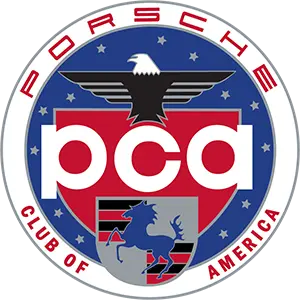The Infamous IMS Saga
THE INFAMOUS INTERMEDIATE SHAFT (IMS) SAGA
*Information compiled from LN Engineering*
IMS 101
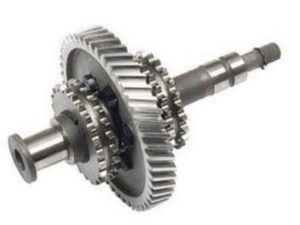
The purpose of the intermediate shaft is to drive the camshafts indirectly off the crankshaft. By using an intermediate shaft, the speed of the chains are reduced, which is better for chain life. This basic design was used throughout the entire lifespan of the aircooled six-cylinder Mezger engine used through 1998. The inclusion of an intermediate shaft which drives the camshafts indirectly off the crankshaft has been a mainstay of the horizontally-opposed flat 6 engine utilized by Porsche.
The most common deficiency with the M96 engine and its revisions through 2008 is the failure of the ball-bearing found in the intermediate shaft. The intermediate shaft found in the M96 and later M97 engine was revised three times. The earliest design incorporated a dual-row ball bearing used through model year 1999 and in some 2000 and 2001 models. Starting in model year 2000, Porsche began phasing out the dual row bearing and went to a smaller single row, with significantly less load capacity. From model year 2002 -2006, all engines used this smaller, lower capacity bearing. Starting with the 2006 model year, the design was again revised to use a much larger single row bearing with the same load capacity of the early dual-row ball-bearings.
This bearing increased in diameter, which increased the bearing and ball speed, further improving the bearing. However, starting with the 2006 model year, Porsche in its third revision of the intermediate shaft bearing, changed over to a design that is not serviceable, leaving later model years with no recourse for addressing this issue with preventative maintenance, which failures still frequent. In all revisions, a sealed ball-bearing was used, rather than allowing for engine oil to lubricate and cool the ball-bearing. There is no recommended service interval for these bearings nor provisions for their replacement from the factory. However, with model year 1997 through 2005 engines, the intermediate shaft bearing thankfully is serviceable and with preventative maintenance, costly repairs can be prevented.
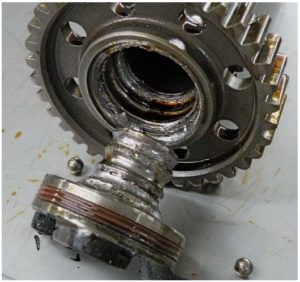
By far, the single row ball-bearing used starting in model year 2000 through 2005 are the most problematic. Based off projections calculated by a fellow Porsche enthusiast and retired bearing engineer from Timken, they figure a 90% survival rate of the single-row 6204 ball-bearing used in the IMS at 90,000 miles* – resulting in a staggering 10% failure rate (called the Ll0 life)! *Assuming an average speed of 60mph in top gear. This coincides with the high number of failures we see in these model years. Regardless, all M96 and M97 engines from 1997 through 2008 can suffer intermediate shaft bearing failures at any mileage and at any time.
For those with MY06-08 intermediate shafts that cannot have their bearings replaced, we recommend to remove the grease seal from the existing ball bearing, which allows for engine oil to lubricate the bearing, but only when doing another procedure like a clutch, flywheel, or rear main seal replacement. However, this bearing is still problematic and should be upgraded anytime the engine is apart or if replacing the intermediate shaft with a new replacement shaft.
That said, we are advising our customers that proactive disassembly of their engines is not required nor recommended unless performing other upgrades. Beginning with MY09, the M97 engine was retired and was replaced with the 9A1 engine which features improvements such as direct fuel injection and more notably, the lack of an intermediate shaft or IMS bearing.
Further technical information: The [Mezger intermediate shaft] design has been retained with the watercooled 996 Turbo, GT2, and GT3 models as their engines are based off the same 964 engine case with the same internals as the earlier aircooled engines. This intermediate shaft features plain bearings (no ball bearings) that are pressure fed engine oil for lubrication and never fail. If these bearings wear out, the engine may develop a slight knocking noise due to increased running clearance, but this condition will never result in a catastrophic engine failure.
When the M96 engine was developed, for cost savings, one cylinder head casting was made. As such, for interchangeability, the camshafts could no longer be driven off one end of the IMS.
This required that the chains be driven off opposite ends of the intermediate shaft.On the rearmost side of the intermediate shaft (closest to the flywheel), you have the main sprocket the drives the intermediate shaft off the crank as well as a smaller sprocket and chain that goes to one of the cylinders heads to drive the cams. Clear on the opposite end of the intermediate shaft there is another sprocket to drive the cams for the opposite cylinder head. This end of the intermediate shaft has a plain bearing surface integrated into the front oil pump console that is pressure fed oil for lubrication directly from the oil pump. As a result, this end of the IMS always performs flawlessly and never shows wear.
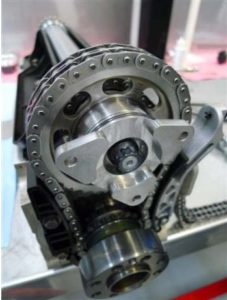
Unfortunately, due to how the crankcase was designed, there are no oil passages from which pressurized engine oil can be used to lubricate a plain bearing on the side closest to the flywheel. The IMS in the M96 (and subsequent M97) engine is located directly beneath the crankshaft carrier and is connected to the crankshaft by means of a chain. The IMS has a sealed ball bearing on one end (closest to the flywheel) and a plain bearing on the other end, which resides in the oil pump/coolant console. Additionally, it is this ball-bearing that handles the
majority of the load on the intermediate shaft.
According to information published about the Eisen IMS Class Action Lawsuit, the single row IMS bearing used in 2000 through 2005 model years is reported to have an 8% failure rate, versus less than 1% with the dual row IMS bearing. The 8% failure rate cited by the settlement documents is not far off of the calculated L10 life LN Engineering has been using for the last five years! With half the load capacity, it is clear to see that the reduced load capacity of the single row IMS bearing is a significant contributing factor to the increased number of failures.
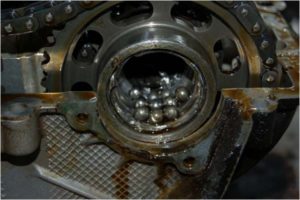
In addition to ball-bearing failures, the intermediate shaft can suffer other failures including but not limited to slippage of drive sprockets which can lead to valve timing related failures. Again, as a cost saving measure, the sprockets were not secured to the intermediate shaft. The center bearing support stud was manufactured with an o-ring groove cut into it, reducing its crosssectional thickness to less than the diameter of the threads used to secure the IMS bearing assembly. As such, it is common to have the center bearing support stud break during operation, resulting in a large oil leak, and is often an indicator of a failing or failed IMS bearing.
It is not known exactly why these bearings fail, but there are many contributing factors including over-loading. Poor lubrication, long drain intervals, high fuel and moisture content in the engine oil, high oil temperatures, and even operational speeds can also affect bearing life. That’s why some bearings last 3,000 miles and others have lasted over 200,000 miles. Here is a good link about bearing failures and some of the common causes:
http://www.maintenanceworld.com/Articles/manufacturing/bearing-failure.htm
Foreign matter:
One of the most common sources of trouble in bearings is wear and pitting caused by foreign particles and is responsible for 70% of all early bearing failures. With six years and tens of thousands of IMS Retrofit procedures having been carried out since 2008, we have enough experience to confirm that foreign object debris can and will compromise the replacement IMS bearing. We have confirmed documented failures of the [LN Engineering] IMS Retrofit bearing after it was installed as part of a reactionary procedure when the original bearing had already started to fail or had failed completely.
Now for some technical information from our bearing engineering team: “There are many reasons for bearing failure, and usually each failure is due to a combination of causes, not just a single cause. Spalling occurs as a result of normal fatigue where the bearing has reached the end of its normal life span but this is not the most common cause of bearing failure. Spalling detected in bearings can generally be attributed to other factors. A common cause of bearing failure is due to contamination from tiny metallic particles left over from a previous mechanical failure. These particles are suspended in the oil and if they are allowed to get into the bearing, the result is tiny dents in the hard steel raceway. Often the dent is surrounded by a microscopic raised area (or ‘lip’), and when the ball rolls over this lip, the ultra-high point loading exceeds the strength of the steel and it fractures, leaving behind a jagged depression (or ‘pit’). Once this cycle begins, wear is greatly accelerated and the bearing will fail prematurely.”
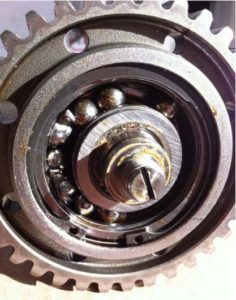
One thing is for sure; once you have experienced an IMS bearing failure, there is no turning back. A complete engine disassembly is required to replace the intermediate shaft and in most cases, complete rebuild or engine replacement is your only option. When an IMS failure occurs, or more specifically the ball-bearing or bearing support fails, the intermediate shaft is damaged beyond the point of being serviceable, but moreover, debris from the failure contaminates the entire engine, requiring a complete teardown and rebuild to recover from such a failure. In worst-case scenarios, the cam timing can also be thrown off, causing valve to piston contact, and in some cases, even lead to a failure that requires replacement of the engine. In that case, the engine will not be accepted as a core, requiring the purchase of another core or to pay an ever-increasing core charge from Porsche on top of the cost of the replacement engine. Aside from the proactive approach of replacing the IMS bearing prior to such a failure, prevention and early detection are some of the steps that can be taken to try to minimize the risk of a costly engine failure.
One attempt at extending the life of the original IMS bearing is removing the grease seals off the factory intermediate shaft bearings to better improve their lubrication and cooling, as is the case with model year 2006 through 2008 engines, as that’s the only preventative measure that can be taken that is cost effective. The other option is to tear down the engine completely to access the intermediate shaft, for which upgraded IMS bearings are available for installation at this point.
With model year 1997 through 2005 engines however, the bearing is indeed accessible. Any IMS bearing replacement is intended to be installed as a proactive measure in preventative and regular maintenance. Once an engine has suffered a failure, replacement of the intermediate shaft bearing is no longer an option. Installing a replacement IMS bearing in an engine that has already suffered a failure will result in a subsequent failure due to collateral damage, including but not limited to debris contaminating the new bearing.
Lubrication:
Oiling is just one part of the IMS failure problem. As supplied by Porsche, the intermediate shaft uses a sealed ball bearing. The original bearing was grease filled, considered a “permanent” lubricant. However, the original bearings and seals used are rated only to 250F and over time, the seals become hard, allowing the grease under normal operation to be “washed” out of the bearing during operation.
Additionally, as the intermediate shaft itself is completely submerged at times, the shaft will actually fill up with engine oil. With long drain intervals, contaminants in the oil find their way into the bearings and intermediate shaft. These worn out seals do allow oil in but they also limit the exchange of fresh oil.
Once the bearing begins to wear, the seal will actually fail completely, allowing for oil to wash out the permanent grease but not allowing for fresh oil to exchange in and out of the bearing during operation. It is at this point that you can begin to find debris in the filter from the seal and from the bearing itself.
The IMS Retrofit uses an open bearing (no grease seal), allow engine oil to freely enter and exit the bearing. The ceramic hybrid bearing used is designed to function on splash lubrication from engine oil alone, but is submerged in oil as well, depending on operating conditions due to its location in the engine’s “integrated dry sump.”
The IMS tube itself will end up storing a sizable amount of oil that will centrifugally be fed to the bearing during operation as it leaks past the rear seal on the new IMS bearing. This is another reason why frequent oil changes are a must – as this oil gets trapped and is one of the sources for lubrication of the new bearing!
Forced oiling of the ball bearing does not provide any benefit as the bearing does not require or benefit from additional oil. Lubrication alone is not the problem. “Rolling element bearings depend on the continuous presence of a very thin – millionths of an inch – elastohydrodynamic film of lubricant between rolling elements and raceways, and between the cage, rings and rolling elements. Lubricant-related failures can be avoided by selecting a grease or oil that generates a sufficient film to keep bearing elements separated. A good lubricant also provides good boundary lubrication. Lubricant failures can be detected by the presence of discolored (blue/brown) raceways and rolling elements. Excessive wear on rolling elements, rings and cages follows, resulting in overheating and subsequent catastrophic failure.” – Applied.com
Some claim without forced oiling of the ball bearing there is inadequate lubrication.
Unfortunately, there is no evidence of this with thousands of stock or ceramic hybrid
replacement bearings LN Engineering has inspected. Furthermore, the bearing operates submerged in oil or partially submerged in normal operation, for example at idle, when bearing load is highest and need for lubrication is greatest. In fact, it’s possible to over-lubricate a bearing, which causes the balls to slide rather than to roll. “Too much oil or grease in a bearing or its housing causes an effect called churning resulting in a sharp temperature rise and often premature lubricant and/or bearing failure.
Circulating oil, however, should not be used in high-speed applications, such as machines tool spindles, because of unacceptable friction losses as the lubricant moves through the bearing. In these applications, only a small amount of oil is needed, and a spray-mist system is generally preferred.” – Petronomics.com
For those choosing to retain the original conventional ball bearing, it has been known for years that simply removing the grease seal will promote improved bearing life along with use of an oil with higher viscosity or higher film strength.
The LN Engineering IMS Retrofit kit should not be used with any forced oiling products for which they were not designed for.
Another issue that forced oiling of a ball bearing does not solve is over-loading of the ball bearing. The single row ball bearing used starting in 2000 through 2005 was replaced with a larger bearing in 2006 with double the load capacity, restoring the original load capacity the dual row bearing first used in the M96 engine(1997-99). Insufficient load capacity leading to wear and fatigue is the primary problem with the single row bearing used in 2000 through 2005, not lubrication! It is for this same reason that the class action lawsuit settlement regarding the IMS only covers vehicles with the single row bearing as found in 2000 through 2005 model year vehicles!; http://www.imsporschesettlement.com/
Prevention
First of all, there’s no need to loose sleep over IMS failures! The best preventative measures that can be taken are to be religious with your maintenance schedule. But keep reading, there’s more that you can do.
So what can be done to minimize the likelihood of an IMS failure?:
Although a greatly debated subject, most experts agree that more frequent oil changes every 6 months or 5,000 miles is a good first step. If you drive short distances frequently or in cold climates, more frequent changes every 3,000 miles or 3 months is advisable. One of the most common sources of trouble in bearings is wear and pitting caused by foreign particles and is responsible for 70% of all early bearing failures. As the IMS Retrofit employs an open bearing and is lubricated by engine oil in the crankcase, filtration is even more important. We use factory Mann, Mahle, or Hengst oil filters because of their high quality standards.
Secondly, use of premium engine oil such as Total Quartz 5w40 (which is a Porsche approved oil) can also provide added protection to all critical engine components. By no means should you use any oil thinner than a 0w40 – do not use 0w30, 5w30, or 10w30 viscosities! Also, use of low SAPS oil (has less Zn and P) isn’t recommended.
Lastly, actually driving your Porsche more often and avoiding higher gears in order to keep the revs above 2500-3000 rpm is another good step to take to improve the life of the ball-bearing in the intermediate shaft(the faster you spin the IMS bearing, the longer it will last and less it will wear). Although there is limited data, the general trend is that lower mileage vehicles with infrequent oil changes or driven light-footed (as in run at low speed/engine rpms) are most likely to suffer a failure rather than those cars that are driven hard and well-maintained.
Along with more frequent oil changes, the addition of a magnetic drain plug coupled with close inspection of the oil filter and magnet at these shorter intervals may help owners identify a failure in its early stages, but later models using the single row bearing can fail with little warning. When inspecting the filter and magnetic drain plug, ferromagnetic debris from the intermediate shaft bearing can be identified easily, appearing like silver glitter. Larger debris than this is indicative of a complete failure. With proper lubrication, more frequent oil changes, and spirited driving, longevity of your original IMS can be greatly extended.
For those with MY06-08 intermediate shafts that cannot have their bearings replaced, we recommend to remove the grease seal from the existing ball bearing, which allows for engine oil to lubricate the bearing, but only when doing another procedure like a clutch, flywheel, or rear main seal replacement.
Timing is everything. If you wait too long, a catastrophic failure may preclude the ability to replace your IMS bearing with an IMS Retrofit™ kit. Remember, often there is little warning of an impending IMS failure. Bare minimum, you need add a magnetic drain plug. This makes for easy inspection for IMS debris at time of performing an oil change.
Any oil leaks at the rear of the engine should be checked out immediately – it is common to think you have a RMS leak, but in fact, a failing bearing can cause the IMS flange seal to leak.
Lastly, any technician who knows what a failing water pump or idler belt bearing sounds like should be able to use a stethoscope to listen to the IMS for similar problems from the general vicinity of the IMS bearing. If there is any noise that may be IMS related, remove the serpentine belt to isolate idler pulleys, power steering pump, alternator, and even water pump noise.
Replacement
Are you new to the M96 engine and the IMS Retrofit? There are several versions of the IMS used from 1997 through 2008.
LN Engineering currently offers a dual row IMS Retrofit as well as a single row IMS Retrofit, where the engine does not have to be disassembled to replace the factory sealed ball-bearing.
The LN Engineering IMS Retrofit uses a custom open (no grease seal) ceramic hybrid bearing (US or Japan sourced components).
Typically, replacement of the IMS bearing takes 10+ hours when also replacing the clutch assembly at the same time.
All MY97-99 vehicles with their original engines will require a dual row Retrofit™ kit, identified by a wider dual row ball-bearing and narrow IMS flange.
MY00-01 vehicles may need either a dual row or single row Retrofit™ kit, so you must inspect the flange and compare to the photos of the dual row and single row IMS shown below to determine which kit is needed.
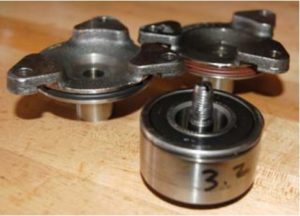
MY02-05 will need a single row Retrofit™ kit, identified by a narrower single row ball-bearing and wider IMS flange.
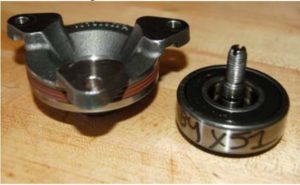
Some late model year 2005 engines were fitted with a larger bearing that is not serviceable without a complete teardown of the engine. All MY06 through MY08 engines will have the larger single row ball-bearing identified by the larger 22mm nut. These cannot be serviced without complete disassembly of the engine due to the intermediate shaft being redesigned! LN Engineering does offer a MY06-08 IMS Retrofit kit for the larger bearing found on model year 2006 through 2008 M97 engines, but engine disassembly is required for installation.
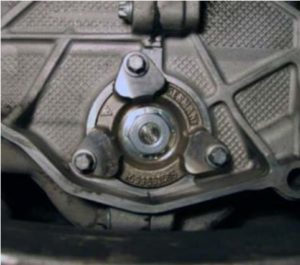
LN Engineering also offers an IMS Upgrade service where you send in your intermediate shaft and it is upgraded to a triple row bearing (with exception of MY06-08). Additionally, the main drive sprocket is pinned to prevent slippage of the drive gear, which is a known problem area.
Additionally, if the engine is not original to the car, for example a car that might have a replacement engine, it will have whatever type bearing was currently in production for the model year in which the engine was built. One easy sign that you have a re-manufactured factory engine that has been replaced is if there is an X in the engine number located on the lower edge of the engine’s sump.
The IMS Retrofit and IMS Solution procedures are intended for PREVENTATIVE and not REACTIVE measures only and should be considered a maintenance item, like a timing belt on many modern engines. By no means should an IMS Retrofit procedure be carried out if the original bearing has started to fail as the intermediate shaft will be damaged by such failure.
Once your original bearing has failed it is too late. If the IMS bearing needs to be cut out of the IMS bearing tube (shaft) to remove it, by no means can a new bearing be installed! The engine will have to be disassembled and intermediate shaft replaced.
Considering all three revisions of the IMS found in the M96 and M97 are known to fail, LN Engineering knows the original use of a ball-bearing was a manufacturing constraint and a poor choice. That said, even the addition of a ceramic hybrid ball-bearing with its superiority over conventional ball bearings does not eliminate completely the chance of failure. With zero failures of their dual row IMS Retrofit, triple bearing IMS Upgrade, or even with their upgraded ceramic hybrid bearings used in the model year 2006 through 2008 intermediate shafts, LN Engineering has almost a perfect track record. Knowing the single row bearing is undersized for
this application, LN Engineering recommends replacement every 4 years or 50,000 miles.
Fast forward to 2009, Porsche’s newest lineup of Boxster, Cayman, and 911 models feature their newest 9A1 engine, which no longer utilize an intermediate shaft to drive the camshafts, but rather drive them directly off the crankshaft.
Recommended Service Intervals:
The Classic Single Row IMS Retrofit has a 4yr or 50,000 mile service interval. Replacement is recommended at time of clutch service and upgrading to the new Single Row Pro IMS Retrofit is recommended.
The Dual Row IMS Retrofit and new Single Row Pro IMS Retrofit both have a 6yr or 75,000 mile service interval.
Information courtesy of LN Engineering.
Please feel welcome to post here with any questions.
Jeremy Williams is the Oregon PCA Technical editor. He co-owns Matrix Integrated Inc. (Matrix Integrated Inc.) with his brother Justin. Jeremy can be reached at [email protected]



